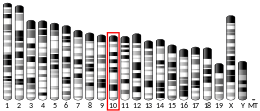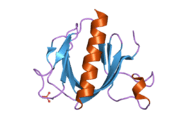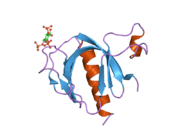ARHGAP9
Rho GTPase-activating protein 9 is an enzyme that in humans is encoded by the ARHGAP9 gene.[5][6]
Function
This gene encodes a member of the Rho-GAP family of GTPase activating proteins. The protein has substantial GAP activity towards several Rho-family GTPases in vitro, converting them to an inactive GDP-bound state. It is implicated in regulating adhesion of hematopoietic cells to the extracellular matrix. Multiple transcript variants encoding different isoforms have been found for this gene.[6]
gollark: Is it 40%? Might be 10%, I think it's 40%.
gollark: Plants don't need much energy.
gollark: Current solar is 40% efficient. There's not a huge way to go.
gollark: There are limits.
gollark: You need to cover vast areas of land with them to get decent output, plus the giant batteries.
References
- GRCh38: Ensembl release 89: ENSG00000123329 - Ensembl, May 2017
- GRCm38: Ensembl release 89: ENSMUSG00000040345 - Ensembl, May 2017
- "Human PubMed Reference:". National Center for Biotechnology Information, U.S. National Library of Medicine.
- "Mouse PubMed Reference:". National Center for Biotechnology Information, U.S. National Library of Medicine.
- Furukawa Y, Kawasoe T, Daigo Y, Nishiwaki T, Ishiguro H, Takahashi M, Kitayama J, Nakamura Y (Jun 2001). "Isolation of a novel human gene, ARHGAP9, encoding a rho-GTPase activating protein". Biochemical and Biophysical Research Communications. 284 (3): 643–9. doi:10.1006/bbrc.2001.5022. PMID 11396949.
- "Entrez Gene: ARHGAP9 Rho GTPase activating protein 9".
External links
- Human ARHGAP9 genome location and ARHGAP9 gene details page in the UCSC Genome Browser.
- Human RGL1 genome location and RGL1 gene details page in the UCSC Genome Browser.
Further reading
- Peck J, Douglas G, Wu CH, Burbelo PD (Sep 2002). "Human RhoGAP domain-containing proteins: structure, function and evolutionary relationships". FEBS Letters. 528 (1–3): 27–34. doi:10.1016/S0014-5793(02)03331-8. PMID 12297274.
- Kimura K, Wakamatsu A, Suzuki Y, Ota T, Nishikawa T, Yamashita R, Yamamoto J, Sekine M, Tsuritani K, Wakaguri H, Ishii S, Sugiyama T, Saito K, Isono Y, Irie R, Kushida N, Yoneyama T, Otsuka R, Kanda K, Yokoi T, Kondo H, Wagatsuma M, Murakawa K, Ishida S, Ishibashi T, Takahashi-Fujii A, Tanase T, Nagai K, Kikuchi H, Nakai K, Isogai T, Sugano S (Jan 2006). "Diversification of transcriptional modulation: large-scale identification and characterization of putative alternative promoters of human genes". Genome Research. 16 (1): 55–65. doi:10.1101/gr.4039406. PMC 1356129. PMID 16344560.
- Rual JF, Venkatesan K, Hao T, Hirozane-Kishikawa T, Dricot A, Li N, Berriz GF, Gibbons FD, Dreze M, Ayivi-Guedehoussou N, Klitgord N, Simon C, Boxem M, Milstein S, Rosenberg J, Goldberg DS, Zhang LV, Wong SL, Franklin G, Li S, Albala JS, Lim J, Fraughton C, Llamosas E, Cevik S, Bex C, Lamesch P, Sikorski RS, Vandenhaute J, Zoghbi HY, Smolyar A, Bosak S, Sequerra R, Doucette-Stamm L, Cusick ME, Hill DE, Roth FP, Vidal M (Oct 2005). "Towards a proteome-scale map of the human protein-protein interaction network". Nature. 437 (7062): 1173–8. doi:10.1038/nature04209. PMID 16189514.
- Colland F, Jacq X, Trouplin V, Mougin C, Groizeleau C, Hamburger A, Meil A, Wojcik J, Legrain P, Gauthier JM (Jul 2004). "Functional proteomics mapping of a human signaling pathway". Genome Research. 14 (7): 1324–32. doi:10.1101/gr.2334104. PMC 442148. PMID 15231748.
This article is issued from Wikipedia. The text is licensed under Creative Commons - Attribution - Sharealike. Additional terms may apply for the media files.







